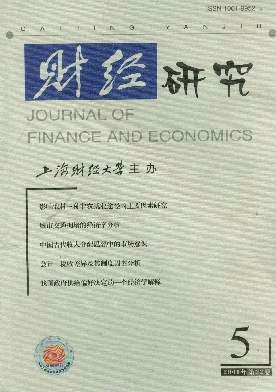腐败影响的宏观经济分析
财经研究 2006 年 第 32 卷第 05 期, 页码:120 - 129
摘要
参考文献
摘要
文章首先将腐败引入Arrow-Kurz-Barro新古典生产函数,在Ramsey-Cass-Koopmans模型框架下,建立宏观经济动态模型,求解最优条件、讨论稳态均衡值的存在性和稳定性,并进行稳态比较的动态分析和短期分析。研究结果表明,贿赂水平的永久增加将减少稳态的资本积累,但对稳态消费的影响则呈现多种可能;短期贿赂水平变动对资本存量与消费水平的影响也呈现出多种可能性。
[1]Abed G T,Davoodi H R.Corruption,structural reforms,and economic performance inthe transition economies[C].G T Abed,S Gupta.Governance,corruption and eco-nomic performance[A].International Monetary Fund,Washington,DC,2002.
[2]Acemoglu D,Verdier T.Property rights,corruption and the allocation of talent:Ageneral equilibrium approach[J].Economic Journal,1998,108,450:1381~1403.
[3]Aidt S T.Economic analysis of corruption:A survey[J].Economic Journal,2003,113(491):632~52.
[4]Baumol W J.Entrepreneurship:Productive,unproductive,and destructive[J].Journalof Political Economy,1990,98(5):893~921.
[5]Becker G.Crime and punishment:An economic approach[J].The Journal of PoliticalEconomy,1968,76,2(March~April):169~217.
[6]Bliss Christopher,Rafael Di Tella.Does competition kill corruption?[J].Journal ofPolitical Economy 1997,105,51(October):1001~1023.
[7]Braguinsky Serguey.Corruption and schumpeterian growth in different economic envi-ronments[J].Contemporary Economic Policy,1996,14(July):14~25.
[8]Cheung Steven N S.A simplistic general equilibrium theory of corruption[J].Contem-porary Economic Policy,1996 14(July):1~5.
[9]Kaufmann D,Shang-Jin Wei.Does“grease money”speed up the wheels of commerce?[R].NBER,Working paper,w7093,1999.
[10]GoulderL H,Parry I W H,Burtraw D.Revenue-raising vs.other approaches to envi-ronmental protection:The critical significance of pre-existing tax distortions[J].RandJournal of Economics,1997,28(4):708~31.
[11]Jagdish N Bhagwati.Directly unproductive,profit-seeking(DUP)activities[J].Jour-nal of Political Economy,1982,90(5):988~1002.
[12]Johnson Simon,Daniel Kaufmann,Andrei Shleifer.The unofficial economy in transi-tion[R].Brookings Papers on Economic Activity,1997,2(1):159~239.
[13]Lien D D.A note on competitive bribery games[J].Economics Letters,1986,22(4):337~41.
[14]Lui F T.An equilibrium queuing model of bribery[J].Journal of Political Economy,1985,93(4):760~81.
[15]Lui F T.Three aspects of corruption[J].Contemporary Economic Policy,1996,14(3):26~29.
[16]Mo P H.Corruption and economic growth[J].Journal of Comparative Economics,2001,29(1):66~79.
[17]Murphy K M,Shleifer A,Vishny R W.The allocation of talent:Implications forgrowth[J].Quarterly Journal of Economics,1991,106(2):503~30.
[18]Murphy K M,Shleifer A,Vishny R W.Why is rent-Seeking so costly to growth[J].The American Economic Review 1993,83,2(May):409~414.
[19]Paolo Mauro.Corruption and growth[J].The Quarterly Journal of Economics,1995,106,2(August):681~711.
[20]Paolo Mauro.The persistence of corruption and slow economic growth[R].IMF StaffPapers,2004,51(1).(Also see International Monetary Fund,WP/02/213.)
[21]Pranab Bardhan.Corruption and development:A review of issues[J].Journal of Eco-nomic Literature,1997(Sept):1320~1346.
[22]Posner R A.The social costs of monopoly and regulation[J].Journal of Political E-conomy,1975,83(4):807~827.
[23]Shleifer A,Vishny R W.Politicians and firms[J].Quarterly Journal of Economics,1994,109(4):995~1026.
[24]Shleifer A.Government in transition[J].European Economic Review,1997,41(3):385~410.
[25]Tanzi V.Corruption around the world:Causes,consequences,scope,and cures[R].IMF Staff Papers,1998,45(4):559~94.
[26]Tullock G.Corruption theory and practice[J].Contemporary Economic Policy,1996,14(July):6~13.
[27]龚六堂.动态经济学方法[M].北京:北京大学出版社,2000.
①腐败监督组织“透明国际”(Transparency International,TI)新近公布的年度报告中显示,在其2005年所调查的全球159个国家中,有2/3的国家存在着严重的腐败现象。
②透明国际的清廉指数(Corruption Perceptions Index,CPI)是一种复合民意调查,它反映的是全球各国商人或国情分析研究专家对一个国家腐败状况的观察和感受,他们包括本国的或外国派驻人员。2005年的指数排行是从10个独立研究机构发表的16个调查结果平均以后求出的结果。但透明国际清廉指数呈现的仅仅是一种快照似的主观感受统计,难以反映全面的状况。Transparency International,Transparency InternationalCorruption Perceptions Index 2005,http://www.transparency.org/cpi/2005/2005.10.18.cpi.en.html.
③The World Bank,http://www1.worldbank.org/publicsector/anticorrupt/index.cfm(accessed on 20 January 2005).Also see World Bank(2000).
④The IMF,http://www.imf.org/external/np/exr/facts/gov.htm(accessed on 20 Janu-ary 2005).
⑤本文对腐败的定义显然与政治腐败(例如在选举中购买选票、非法的财产捐助活动、其他特殊利益集团对法律和规定施加影响等)有所不同。
⑥参见Becker(1968)关于犯罪与最优监督的理论分析,其中他给出了腐败作为均衡的行为模式的经典经济学解释,潜在犯罪分子的理性选择行为依赖于:(1)社会对犯罪的监督成本;(2)犯罪能够获得的超额利益;(3)犯罪分子预期的被抓获的风险以及预期会受到的惩罚的强度。
⑦Mauro(2002、2004)的研究指出,当经济中其他当事人能从腐败中获得超额收益时,个体的决策不仅依赖于合法活动获得的较低的边际产量,还将依赖于腐败活动获得的较高的边际产量。因此,从这方面来看,在腐败盛行的环境中个体多一些寻租、少一些生产性活动的资源配置可能是有利可图的。
⑧本文假设生产函数满足2f(k,b)/kb
[2]Acemoglu D,Verdier T.Property rights,corruption and the allocation of talent:Ageneral equilibrium approach[J].Economic Journal,1998,108,450:1381~1403.
[3]Aidt S T.Economic analysis of corruption:A survey[J].Economic Journal,2003,113(491):632~52.
[4]Baumol W J.Entrepreneurship:Productive,unproductive,and destructive[J].Journalof Political Economy,1990,98(5):893~921.
[5]Becker G.Crime and punishment:An economic approach[J].The Journal of PoliticalEconomy,1968,76,2(March~April):169~217.
[6]Bliss Christopher,Rafael Di Tella.Does competition kill corruption?[J].Journal ofPolitical Economy 1997,105,51(October):1001~1023.
[7]Braguinsky Serguey.Corruption and schumpeterian growth in different economic envi-ronments[J].Contemporary Economic Policy,1996,14(July):14~25.
[8]Cheung Steven N S.A simplistic general equilibrium theory of corruption[J].Contem-porary Economic Policy,1996 14(July):1~5.
[9]Kaufmann D,Shang-Jin Wei.Does“grease money”speed up the wheels of commerce?[R].NBER,Working paper,w7093,1999.
[10]GoulderL H,Parry I W H,Burtraw D.Revenue-raising vs.other approaches to envi-ronmental protection:The critical significance of pre-existing tax distortions[J].RandJournal of Economics,1997,28(4):708~31.
[11]Jagdish N Bhagwati.Directly unproductive,profit-seeking(DUP)activities[J].Jour-nal of Political Economy,1982,90(5):988~1002.
[12]Johnson Simon,Daniel Kaufmann,Andrei Shleifer.The unofficial economy in transi-tion[R].Brookings Papers on Economic Activity,1997,2(1):159~239.
[13]Lien D D.A note on competitive bribery games[J].Economics Letters,1986,22(4):337~41.
[14]Lui F T.An equilibrium queuing model of bribery[J].Journal of Political Economy,1985,93(4):760~81.
[15]Lui F T.Three aspects of corruption[J].Contemporary Economic Policy,1996,14(3):26~29.
[16]Mo P H.Corruption and economic growth[J].Journal of Comparative Economics,2001,29(1):66~79.
[17]Murphy K M,Shleifer A,Vishny R W.The allocation of talent:Implications forgrowth[J].Quarterly Journal of Economics,1991,106(2):503~30.
[18]Murphy K M,Shleifer A,Vishny R W.Why is rent-Seeking so costly to growth[J].The American Economic Review 1993,83,2(May):409~414.
[19]Paolo Mauro.Corruption and growth[J].The Quarterly Journal of Economics,1995,106,2(August):681~711.
[20]Paolo Mauro.The persistence of corruption and slow economic growth[R].IMF StaffPapers,2004,51(1).(Also see International Monetary Fund,WP/02/213.)
[21]Pranab Bardhan.Corruption and development:A review of issues[J].Journal of Eco-nomic Literature,1997(Sept):1320~1346.
[22]Posner R A.The social costs of monopoly and regulation[J].Journal of Political E-conomy,1975,83(4):807~827.
[23]Shleifer A,Vishny R W.Politicians and firms[J].Quarterly Journal of Economics,1994,109(4):995~1026.
[24]Shleifer A.Government in transition[J].European Economic Review,1997,41(3):385~410.
[25]Tanzi V.Corruption around the world:Causes,consequences,scope,and cures[R].IMF Staff Papers,1998,45(4):559~94.
[26]Tullock G.Corruption theory and practice[J].Contemporary Economic Policy,1996,14(July):6~13.
[27]龚六堂.动态经济学方法[M].北京:北京大学出版社,2000.
①腐败监督组织“透明国际”(Transparency International,TI)新近公布的年度报告中显示,在其2005年所调查的全球159个国家中,有2/3的国家存在着严重的腐败现象。
②透明国际的清廉指数(Corruption Perceptions Index,CPI)是一种复合民意调查,它反映的是全球各国商人或国情分析研究专家对一个国家腐败状况的观察和感受,他们包括本国的或外国派驻人员。2005年的指数排行是从10个独立研究机构发表的16个调查结果平均以后求出的结果。但透明国际清廉指数呈现的仅仅是一种快照似的主观感受统计,难以反映全面的状况。Transparency International,Transparency InternationalCorruption Perceptions Index 2005,http://www.transparency.org/cpi/2005/2005.10.18.cpi.en.html.
③The World Bank,http://www1.worldbank.org/publicsector/anticorrupt/index.cfm(accessed on 20 January 2005).Also see World Bank(2000).
④The IMF,http://www.imf.org/external/np/exr/facts/gov.htm(accessed on 20 Janu-ary 2005).
⑤本文对腐败的定义显然与政治腐败(例如在选举中购买选票、非法的财产捐助活动、其他特殊利益集团对法律和规定施加影响等)有所不同。
⑥参见Becker(1968)关于犯罪与最优监督的理论分析,其中他给出了腐败作为均衡的行为模式的经典经济学解释,潜在犯罪分子的理性选择行为依赖于:(1)社会对犯罪的监督成本;(2)犯罪能够获得的超额利益;(3)犯罪分子预期的被抓获的风险以及预期会受到的惩罚的强度。
⑦Mauro(2002、2004)的研究指出,当经济中其他当事人能从腐败中获得超额收益时,个体的决策不仅依赖于合法活动获得的较低的边际产量,还将依赖于腐败活动获得的较高的边际产量。因此,从这方面来看,在腐败盛行的环境中个体多一些寻租、少一些生产性活动的资源配置可能是有利可图的。
⑧本文假设生产函数满足2f(k,b)/kb
引用本文
伏玉林, 苏二毛. 腐败影响的宏观经济分析[J]. 财经研究, 2006, 32(5): 120–129.
导出参考文献,格式为:





 6758
6758  3228
3228

